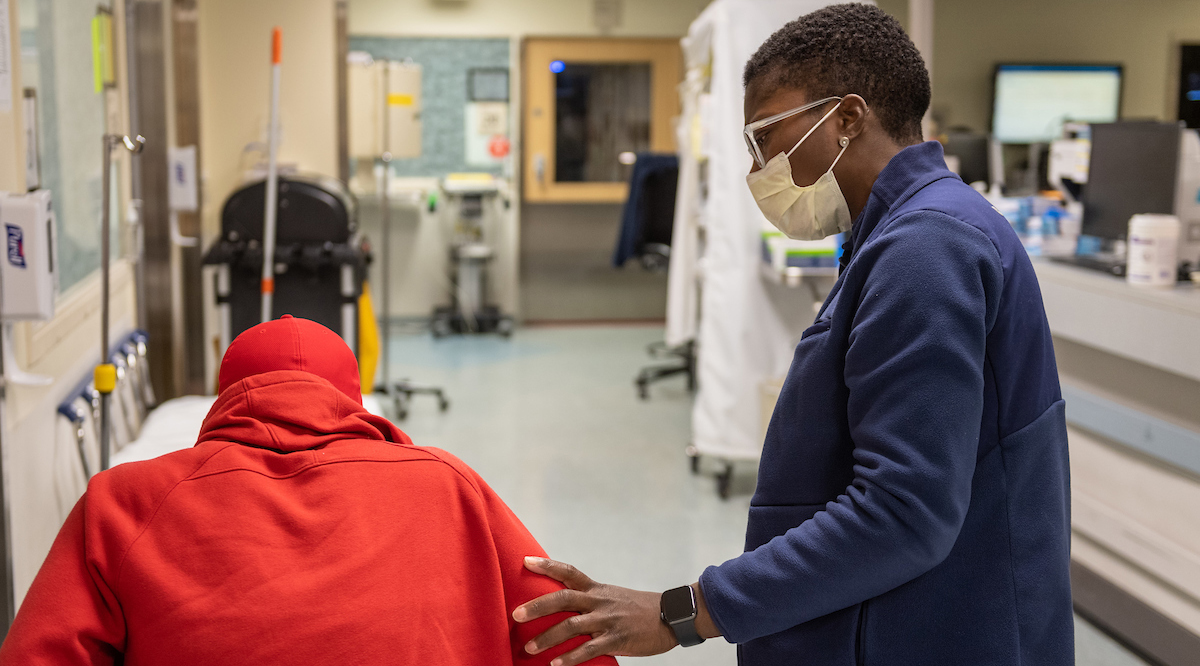
Editor's note: The opinions expressed by the author do not necessarily reflect the opinions of the AAMC or its members.
“I have had the most challenging encounters with the more low-income, African American population, because it's so different than the culture in which I was raised. … [W]hen you're dealing with them, [they seem] less respectful, and a lot of time, they seem less engaged in their health care.” – Dale Sutton*
“This guy who is really well-off, a White guy … I spent probably almost 15 minutes in his room. … The second [African American] guy was very similar to the rest of the people in the department, [and I thought], ‘This is just another heart failure patient who can't afford his meds. All right, we're going to admit him.’ … Probably spent maybe five minutes in his room. … [I] spent more time with the patient who is more like my … cultural identity.” – Jan Amery*
These are just some of the thoughts shared by emergency medicine residents highlighting their biases — conscious and unconscious — when treating patients from diverse backgrounds.
Such stories are worrisome given that these physician trainees care for some of our nation’s most in-need patients: people seeking help in the one place that must provide it — the emergency department (ED).
In a study published in Academic Emergency Medicine Education and Training in September 2021, my colleagues and I asked two dozen medical residents at three different emergency medicine residency programs to describe times that their personal identity differed from patients’. We found several recurring — and disturbing — themes.
Respondents often felt more uncomfortable engaging with patients who were from backgrounds different from their own, who had difficulty communicating their needs in ways the residents were used to hearing them described, and who interacted with the health care system in ways that didn’t match medical residents’ own sense of ideal use. Our study also found instances when providers seemed to blame patients for their problems, in part because they do not understand their patients' life circumstances. For example, respondents described how the care team felt some patients ended up in the ED because they were “neglecting their health.”
ED providers face gaps in knowledge of patients’ medical histories, a lack of long-standing patient-provider relationships, and numerous work distractions — all of which can translate into medical decisions based on stereotypes or gut feelings instead of best medical practice.
These findings have serious implications for the care and treatment of ED patients. While all medical specialties need to grapple with race-related disparities and other health inequities, emergency medicine is unique in several crucial ways.
ED providers often treat patients who face numerous personal and structural barriers to care. African American and Medicaid patients have the highest ED use rates in the United States, for example. And because our patients sometimes are desperately ill, ED providers sometimes are making life-and-death decisions.
In addition, the ED is often organized chaos, with a rapid influx of patients and a broad range of diagnoses. ED providers face gaps in knowledge of patients’ medical histories, a lack of long-standing patient-provider relationships, and numerous work distractions — all of which can translate into medical decisions based on stereotypes or gut feelings instead of best medical practice. And those decisions can be dangerous. Consider, for example, that non-White patients are more likely to be discharged from the ED following heart attacks.
If we want young doctors to effectively and compassionately care for some of our most medically vulnerable patients, we need to take certain crucial steps.
Cultural humility and other essential topics
Too often, residents don’t fully understand their patients’ cultural and socioeconomic backgrounds. Simply placing residents in clinical sites with patients from under-resourced backgrounds is insufficient. Because the practice of medicine hinges on a provider’s ability to connect with patients and to understand the upstream factors that influence their lives and their health outcomes, emergency medicine residency programs need to actively teach certain topics. These include structural competency — an awareness of legal, social, and economic policies that affect health care and community resources. They also include cultural humility — a willingness to learn from patients as valued experts on their lived experiences. And they include education about providers’ own implicit and explicit biases.
Teaching about provider biases and health inequities must be done carefully, or it may not necessarily equate to behavior change. That’s because these topics can unintentionally stir feelings of guilt or provoke apathy in the face of the vastness of the problem. It’s possible to help address these feelings by acknowledging them — noting, for example, that all people have biases. The key is to notice and try to address them.
Once is not enough
To be effective, these topics cannot be haphazardly inserted into a curriculum but instead should be infused as an ongoing thread throughout all relevant educational content. For example, the Emory emergency medicine residency program in Atlanta piloted a redesign that requires all core lectures to include content on health disparities. Doing so allows residents to see connections between social factors and diseases and their management.
Less formal learning
Programs need to offer residents different formats for discussing issues related to health inequities. Recently, the University of Michigan in Ann Arbor and other emergency medicine residency programs added town hall sessions to provide a forum for open discussions on race and equitable care.
Other effective options are small group discussions and reflective writing activities designed to spur introspection and meaningful conversations. For example, one curriculum on social determinants of health asks trainees to imagine specific obstacles that a patient with no transportation or housing faces in accessing health care.
Use real-world cases
Theoretical concepts come alive when they are explicated with concrete examples. One curriculum on racial inequities and racism draws from contemporary cases of biased behavior toward patients, prompting discussions of the historical or societal influences on them. The training concludes with a focus on personal and institutional strategies to prevent such behaviors.
Another effective option is using morbidity and mortality rounds — those in-depth discussions of times when patient care is less than ideal — to explore how social or identity-related factors influence health outcomes.
Finally, an institution’s electronic medical records can be used to develop interactive dashboards, allowing residents to detect disparities in care among ED patients. Such data can reveal how wait times, services provided, or health outcomes vary by such patient demographics as race, ethnicity, and language.
Provide mentors and honor our mission
The residents in our survey described looking for role models — educators who could teach them how to care for a wide variety of patients. Unfortunately, emergency medicine is one of several medical specialties in which persons from racial and ethnic minority backgrounds are underrepresented. So, any efforts to improve training on health inequities must also include recruiting and retaining faculty members from diverse backgrounds and addressing barriers along the pathway to emergency medicine.
Emergency medicine has set an intention to care for a unique population: anyone who walks through the ED doors. But do our educational environment and culture support this goal? We can no longer assume that our white coats shield us from perpetuating inequities, and instead must prepare our trainees to provide equitable, appropriate, and compassionate care to all.
*A pseudonym
Adrianne Haggins, MD, is an assistant clinical professor in the Department of Emergency Medicine at the University of Michigan Medical School in Ann Arbor. Her research interests include disparities in health care access, physician workforce diversity, and improving care to populations that have been historically marginalized.
